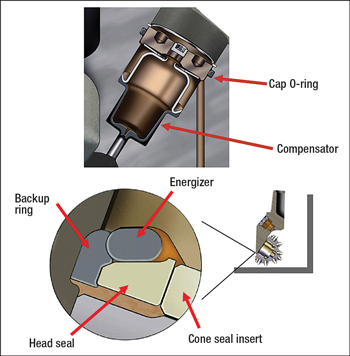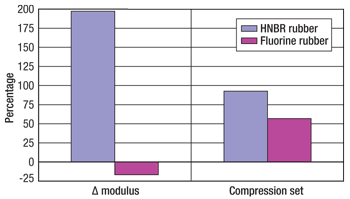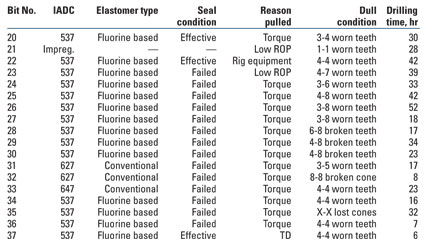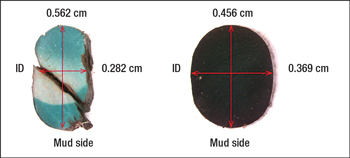David Shakhovskoy, Geodynamics; Aaron Dick, Gary Carter and Martin Jacobs, Baker Hughes
When drilling into oil, gas and geothermal reservoirs located in deep and/or geologically active areas, high temperatures place great demands on the thermal performance of drilling systems. Additionally, the lithologies drilled to gain access to these reservoirs are often hard rock, requiring the use of roller-cone drill bits. Conventional rubber seal components used in roller-cone drill bits are typically rated for temperatures up to 150°C (302°F), and become thermally degraded—leading to bearing failure—when subjected to higher temperatures than these.
To make a roller-cone drill bit capable of operating at higher downhole temperatures, new rubber compounds were developed and tested in laboratory experiments to characterize their high-temperature behavior. Then, drill bits containing these rubber compounds were used to drill the 8½-in.-diameter vertical well section of a geothermal well in the Cooper Basin of South Australia. Maximum bottomhole circulating temperatures were estimated to be 170°C (338°F) while drilling the granite basement below 3,500 m (11,500 ft); however, temperature indicators showed that the bits were exposed to temperatures greater than 260°C (500°F).
Seventeen drill bits were used: 14 containing mechanical face seals and high-temperature-rated rubber components and three containing mechanical face seals and conventional rubber components. Filtered run data demonstrated that the bits with high-temperature rubber ran for a 62% greater duration and drilled 27% longer intervals than the bits containing conventional rubber components, although changes in formation temperature and borehole deviation may have skewed the results. Post-drill examination of the high-temperature rubber components found them pliable and resilient, suggesting that they were still functional.
The improved performance of the high-temperature rubber components extends the advantages of mechanical seals in high-temperature roller-cone drilling applications. Longer runs and the resultant greater footage drilled positively impact the well installation costs that consume between 42% and 95% of capital expenditures for a typical geothermal power facility.1
INTRODUCTION
A 50-MW geothermal pilot is planned to demonstrate the feasibility of the “hot fractured rock,” or HFR, geothermal concept in the Cooper Basin in South Australia. Well target depths are between 4,000 m (13,000 ft) and 5,000 m (16,000 ft) where surveys suggest formation temperatures ranging 225–280°C (437–537°F). The lithology encountered while drilling to these depths is a variety of sandstones and siltstones until the granite basement is encountered between 3,500 m (11,500 ft) and 4,000 m (13,100 ft).
Selection of drill bits to complete these wells required weighing several considerations. Hard rock such as granite is best drilled with tungsten carbide insert roller-cone bits or diamond-impregnated bits. However, thus far, impregnated bits have fallen short of the rate-of-penetration (ROP) requirements for this type of project. Roller-cone drill bits are available with three different bearing-and-seal systems: unsealed bearings, rubber-sealed bearings and mechanical face-sealed bearings. Unsealed-bearing drill bits are often used in geothermal drilling, where well temperatures prevent the use of any seals. However, the usable life of unsealed-bearing bits is limited, as contaminants from the drilling environment enter into and quickly fail the bearing. Sealed-bearing roller-cone drill bits are grease-lubricated and offer greater bearing load capacity and durability.2 In high-temperature applications, mechanical face seals are preferred over rubber seals. The metal-on-metal dynamic sealing surface of the mechanical face seal is more durable and generates less friction and heat than a rubber seal, which tends to slide against the steel in a rubber-sealed bearing.
Conventional downhole tool rubber compounds used in oil and gas drilling—such as acrylonitrile butadiene rubber (NBR) and hydrogenated nitrile–butadiene rubber (HNBR)—become hard and brittle when exposed to temperatures above 150°C (302°F). In addition, components such as O-rings experience compression set (i.e., permanent deformation retained by a component after stress is released) and lose their ability to seal, leading to leakage of drilling fluid into the tool and subsequent failure. Rubber compounds containing fluorine—such as tetrafluoroethylene propylene copolymer (FEPM), fluorocarbon (FKM) and perfluoroelastomer (FFKM)—have better high-temperature properties and are rated for service temperatures as high as 316°C (600°F).3
An investigation was conducted to improve roller-cone drill bit performance in high-temperature applications by replacing the rubber components with fluorine-containing rubber compounds. A roller-cone drill bit contains several rubber components that must be replaced, Fig. 1. In addition to the rubber components that provide the closing force for the bearing mechanical face seal, the bit contains O-rings to seal the jet nozzles and compensator cap. A rubber compensator diaphragm is also used in the pressure compensation system to communicate the external pressure in the borehole to the grease system, thereby minimizing the pressure differential across the bearing seal.
 |
|
Fig. 1. Schematic showing the rubber components contained in a mechanical face-sealed roller-cone drill bit. The bit contains a pressure-compensation diaphragm and cap O-ring (top). The mechanical face seal contains a rubber backup ring and energizer (bottom). A rubber O-ring is also used to seal the jet nozzle (not shown).
|
|
A laboratory test program was executed to characterize the high-temperature properties of fluorine-containing rubber compounds to select the best candidates for drill bit components in high-temperature wells. Candidates were identified and installed in several test drill bits. All rubber components were replaced with fluorine-containing rubber compounds: the mechanical face seal energizer and backup ring, jet nozzle O-ring, pressure compensator diaphragm and compensator cap O-ring.
The Jolokia-1 well was rotary drilled as a vertical exploratory well spudded in March 2008. The 12¼-in. section was drilled with conventional drill bits to the granite basement at 3,700 m (12,100 ft). Seventeen roller-cone drill bits and one impregnated bit were consumed drilling the 8½-in. section to the well completion depth of 4,911 m (16,112 ft). Fourteen of the roller cone drill bits contained mechanical face seals with fluorine-containing rubber components, and the remaining three contained mechanical face seals and conventional rubber components. Temperature indicators were installed in the lubricant system of all bits with fluorine-containing rubber components to record the maximum exposure temperature.
LABORATORY TESTS
O-ring samples of several different fluorine-containing rubber compounds were screened through a series of high-temperature, high-pressure exposure tests. The mechanical properties were measured before and after exposure and compared. Compression set was also measured in order to characterize the amount of permanent deformation that resulted from high-temperature, high-pressure exposure.
Figure 2 compares modulus stability and compression set after aging in water at 200°C (392°F) for 70 hours. Results for an HNBR control sample are shown for comparison. The HNBR samples exhibit large increases in elastic modulus when exposed to test conditions. The fluorine-containing rubber shows a small reduction in elastic modulus (15%), whereas the HNBR sample became very stiff, increasing modulus by 206%. Compression set of the fluorine-containing rubber compounds is much lower (56%) than that of the HNBR control sample (98%).
 |
|
Fig. 2. Results from high-temperature, high-pressure laboratory aging tests performed on HNBR and fluorine-containing rubber samples. The samples were exposed to water at 13.8 MPa (2,000 psi) and 200°C (392°F) for 70 hours. The changes in elastic modulus (left) and compression set (right) are shown.
|
|
These results demonstrate the performance advantage of fluorine-containing rubber compounds in high-temperature, high-pressure environments. The laboratory test results suggest that the operating temperature range of a mechanical face-sealed roller-cone drill bit can be greatly extended by using rubber components molded from fluorine-containing rubber compounds.
FIELD TESTS
The 8½-in. section well plan was to rotary drill with low rotation speed and high weight on bit (WOB) into the hard granite formation to reach a natural fracture system at about 5,000 m (16,400 ft). To maximize drilling time, the drill bits were run to failure by closely monitoring the drillstring torque and pulling the bit when significant torque increases suggested bit failure. Figure 3 shows the average drillstring rotational speed and WOB for each run. Figure 4 shows the rate of penetration (ROP), distance drilled, and drilling time for each of the 17 roller-cone drill bits and the impregnated bit.
 |
|
Fig. 3. Drillstring rotational speed and weight on bit for bits used to drill the 8½-in. section of the Jolokia-1 geothermal exploration well. The impregnated bit 21 was run with a turbine, and the bit rotation speed shown does not include the contribution of the turbine.
|
|
 |
|
Fig. 4. Drilling time, distance drilled and penetration rate for bits used to drill the 8½-in. section of the Jolokia-1 well.
|
|
Table 1 presents the reason that each bit was pulled and the condition of its cutting structure and seals upon inspection. The three roller-cone bits with conventional rubber compounds were bits 31, 32 and 33; the remainder had fluorine-containing rubber compounds. Cutting structures were identical for all the drill bits with fluorine-containing rubber compounds (International Association of Drilling Contractors drill bit classification code 537). Cutting structures were heavier set (i.e., they had shorter tooth projections) for the conventional rubber compound bits 31 and 32 (IADC 627) and bit 33 (IADC 647).
| TABLE 1. Reason for pulling and condition of bits |
 |
Drill bits 27 and 28 were drilled with higher WOB in an attempt to increase the penetration rate. While the penetration rate rose by 0.5 m/hr (1.6 ft/hr) over the previous bit run, the bits lasted about half as long.
Log data were obtained from wireline tools run after the well was completed to 4,911 m (16,112 ft). A three-arm caliper logging downward experienced a temperature-related failure at 4,700 m (15,420 ft) but showed good hole quality to this depth. In addition, the sonic log had a temperature-related failure at 4,520 m (14,829 ft). Survey information showed that the borehole had become highly deviated over the 8½-in. hole section. Inclination was built from vertical (0°) at 3,700 m (12,139 ft) to 39° at the well completion depth. During drilling, the off-bottom torque from drillstring drag had steadily increased with depth; this is believed to have been a result of the deviated borehole.
In order to measure the relative performance of bits having fluorine-containing rubber compounds, the data set was filtered to include only bits that were pulled because of torque and also to exclude bits where the interval average weight on bit was more than one standard deviation from the average for all bits pulled for torque. Table 2 shows the filtered performance data. A significant improvement in drilling time is observed for the bits having fluorine-containing rubber compounds (32.6 hr) relative to the drilling time of bits containing conventional rubber compounds (20.1 hr). The average penetration rate for the drill bits containing conventional rubber compounds was higher, at 3.1 m/hr (10 ft/hr), than the average for the bits with fluorine-containing rubber—2.4 m/hr (7.9 ft/hr). This result suggests that the heavier-set cutting structures were better suited for the formation.
| TABLE 2. Filtered performance data for bits |
 |
The performance data also demonstrates that the drill bits with fluorine-containing rubber compounds performed better in the upper section of the well than in the lower section, where increased formation temperature and hole deviation may have influenced bit performance.
Upon completion of the well, the dulled drill bits from the 8½-in. section were disassembled, and forensic examinations were performed. The temperature indicators installed in the lubricant system were removed and read. While circulation temperatures were estimated to be 170°C (338°F), the indicators showed a maximum exposure temperature greater than 260°C (500°F) for all bits with fluorine-containing rubber components. A temperature log of the completed well showed formation temperature in the 8½-in. section to be 235°C (455°F) at 3,750 m (12,303 ft), increasing to a maximum of 285°C (545°F) at the completion depth of 4,911 m (16,112 ft).
Upon inspection of the bearings and seals, it was confirmed that the drill bits that were run to failure contained compromised seals and drilling mud in the bearings. Sections of O-rings removed from the mechanical face seals of both conventional and fluorine-containing rubber bits are shown in Fig. 5. The image shows severe compression set of the conventional rubber energizer O-ring (99%) and much lower compression set for the fluorine-containing rubber energizer O-ring (37%). In addition, the conventional rubber O-ring had become hard and brittle during the drilling operation, whereas the fluorine-containing rubber retained resiliency.
 |
|
Fig. 5. Cross-sections of a conventional rubber O-ring from bit 32 (left) and from a fluorine-containing rubber compound O-ring from bit 36 (right). Both components had circular cross-sections when installed in their respective drill bits but have become permanently set by high downhole temperatures. The conventional rubber component was brittle and cracked when sectioned. The O-ring cross-sections are oriented with the O-ring inner diameter facing left and the drilling fluid-exposed side facing down.
|
|
CONCLUSIONS
Drill bits capable of high-temperature operation were fabricated by replacing all rubber components with fluorine-containing rubber versions. Testing of these drill bits in a high-temperature geothermal well at temperatures between 170°C (338°F) and 285°C (545°F) showed several indications of improved performance. Among these:
• Average drilling time to failure increased from 20.1 hr to 32.6 hr.
• Average length drilled per bit was increased from 63.1 m (207 ft) to 79.9 m
(262 ft).
• Compression set measured on O-rings removed from the worn drill bits improved from 99% for conventional rubber to 37% for fluorine-containing rubber.
These results obtained from testing drill bits in a single geothermal well should be considered preliminary. The influence of increasing formation temperature and borehole deviation further complicates interpretation. However, the results are considered promising and support further evaluation in future high-temperature oil, gas and geothermal wells. 
ACKNOWLEDGMENT
This article was prepared from the paper “Roller cone drill bits for high-temperature applications in southern Australia” presented at the Geothermal Resources Council Annual Meeting held in Reno, Nevada, Oct. 4–7, 2009.
LITERATURE CITED
1 Tester, J. W., Herzog, H. J., Chen, Z., Potter, R. M. and M. G. Frank, “Prospects for universal geothermal energy from heat mining,” Science & Global Security, 5, 1994, pp. 99–121.
2 Hendrickson, R. R., Carwile, C., Matson, L. and R. W. Winzenried, “Seals for geothermal roller drill bits,” Transactions of the ASME, November 1977, pp. 614–618.
3 Morton, M., Rubber Technology, 3rd Ed., Van Nostrand Reinhold Company, New York, 1987, pp. 322–338, 410–437.
|









